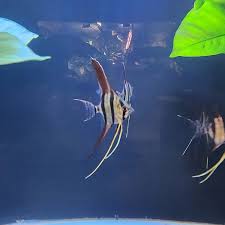1
/
of
1
Midwest Aquarium and Pond Supplier LLC
(19) Atabapo altum angelfish 2''
(19) Atabapo altum angelfish 2''
Regular price
$85.00 USD
Regular price
Sale price
$85.00 USD
Shipping calculated at checkout.
Quantity
Couldn't load pickup availability
Atabapo altum angelfish at 2 inches are wild-caught or tank-bred juveniles of the Pterophyllum altum species. They are known for developing more vivid colors and a taller body shape than other angelfish varieties, but at this small size, they require extremely specific water conditions to thrive.
Identification
At 2 inches, distinguishing a true altum from other angelfish can be challenging. An altum's key identifying features are:
- Forehead: A distinctly concave or "notched" forehead.
- Body: A rounded, disc-shaped body with vertical black bars over a silver base.
- Fins: Longer, flowing dorsal and anal fins compared to the common angelfish, even at a young age.
Origin and habitat
The Rio Atabapo is a "blackwater" river that forms part of the border between Colombia and Venezuela.
- Water parameters: The river's water is highly acidic (pH 4.2–6.2) and very soft, with a temperature range of 82–86°F (28–30°C).
- Natural environment: Altums typically inhabit areas with little current, hiding among tree roots and submerged vegetation.
Care requirements for 2-inch juveniles
Due to their sensitivity, especially at a young age, Atabapo altum angelfish are recommended for experienced aquarists.
- Water quality: Precise water parameters are critical. The tank must have soft, highly acidic, and exceptionally clean water.
- Tank setup: A tall aquarium (at least 90 gallons for a group) with driftwood, roots, and plants is necessary to provide the cover they need.
- Acclimation: Introducing these fish to a new tank requires very slow and careful acclimation to prevent shock from changes in pH or temperature.
- Diet: Juveniles, particularly wild-caught ones, may need live food like brine shrimp to be weaned onto a varied diet of frozen and high-quality prepared foods.
- Social behavior: They are best kept in a group of five or more to reduce aggression and stress.
- Tank mates: Choose peaceful tank mates that are too large to be considered food.
Share
No reviews

